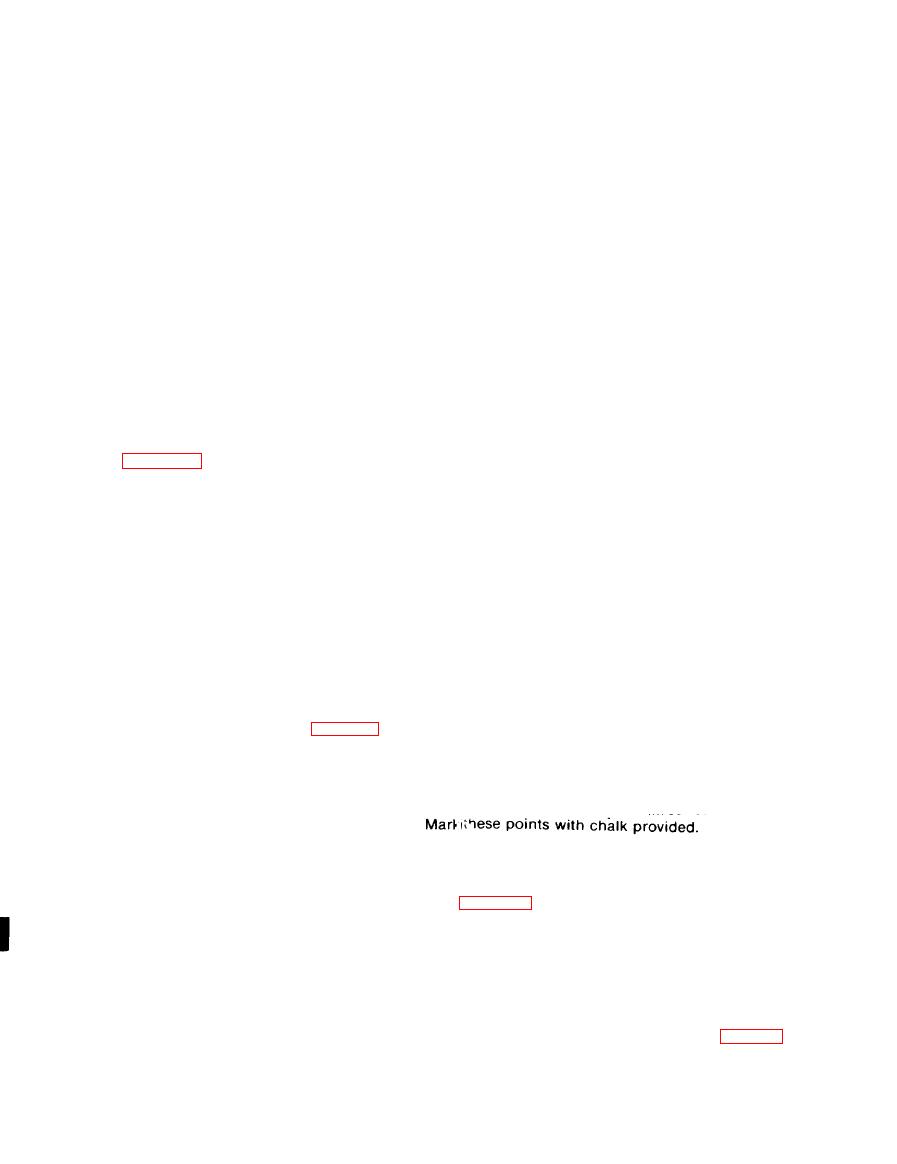
TM 55-6670-200-14&P
h. Level aircraft longitudinally and, if possi-
CAUTION
ble, laterally with main wheels on hanger floor.
Keep aircraft level while jacking to pre-
Use level (12) and leveling bar (10), if required, on
vent cell breakage and damage to air-
aircraft's leveling lugs. For location of leveling
craft.
lugs, consult the Weight and Balance data of air-
craft involved. Level aircraft in accordance with
approved procedure outlined in TM 55-1500-342-23.
g. Set CELL SELECTOR knob (6) to cell on
which applied weight is desired. The pointer on
CAUTION
milliammeter (5) should swing to right. If load on
cell is less than 5,000 pounds, weight on the cell
When leveling, be sure there is no load
can be obtained by turning WEIGHT knob (8) un-
on weighing cells. Excessive side loads
til pointer of meter returns to zero (CELL BAL-
may cause incorrect readings, cell
ANCE arrow). If load on cell is greater than 5,000
breakage, and possible damage to
pounds, turn INITIAL LOAD knob (7) until meter
aircraft.
pointer swings to left, Then turn INITIAL LOAD
knob to next lower position. For example: If lN-
2-3. Operation.
ITIAL LOAD knob is set on 40,000 pounds when
pointer swings to left, return knob to 35,000
a. Set cells on their respective jacks, se-
pounds. Next adjust WEIGHT knob (8) until meter
lecting jack adapters and spherical adapters in ac-
pointer rests on zero. Combined reading of lN-
cordance with figure 2-1. In attaching a weighing
ITIAL LOAD knob (7) and WEIGHT dial (10) is
cell to a jack adapter, be sure adapter is fully
weight on cell.
threaded into cell. If a ring-type adapter is used,
see that it is centered flush on ram, applying a
NOTE
partial load before tightening setscrews.
If initial load has been set too high or
CAUTION
too low, meter pointer cannot be set on
zero. Pegging needle will not damage
Use proper adapters to prevent jacks
indicator.
from slipping or buckling. Damage to
aircraft or inaccurate weight readings
may result if improper adapters are
a. Record weight at three support points in
used. Never apply load to rim of cell.
applicable spaces on Airplane Weighing Form as
b. Set jacks and cells at their respective sup-
shown in Weight and Balance data in TM 55-1500-
port points.
342-23.
b. Make sure aircraft is in a level flight atti-
or 1-3) to ON.
tude. Use plumb bobs provided in kit to establish
points on ground that are directly beneath each
CAUTION
cell and aircraft reference point, as shown in
There must be no load on cells at this
Weight and Balance data in TM 55-1500-342-23.
time.
d. Adjust WEIGHT knob (8) so that WEIGHT
c. Measure horizontal distance from each
dial (10) reads zero. Adjust INITIAL LOAD knob
support to reference datum on a line parallel to
(7) to zero.
aircraft longitudinal axis. Use 50-foot steel tape
(13, figs, 4-26 or 4-27) provided, which is marked
e. Set CELL SELECTOR knob (6) to cell no.1.
in inches and tenths of inches. Enter these mea-
Adjust milliammeter pointer to zero by turning ZERO
surements on weighing form in space provided.
SET knob (9) of cell no. 1. Milliammeter pointer moves
in same direction as rotation of knob. Repeat this
d. At this point, determine whether zero set
procedure for remaining cells.
on cells has been altered by following procedure:
NOTE
(1) Remove all load from cells.
Once cell circuits are zeroed, ZERO
(2) Set INITIAL LOAD knob (7, figs. 1-2
SET knobs (9) must not be touched un-
or 1-3) to zero.
til weight is off cells.
f. Jack aircraft until it is entirely supported
by the three cells.


